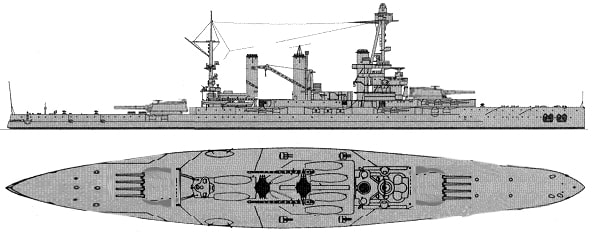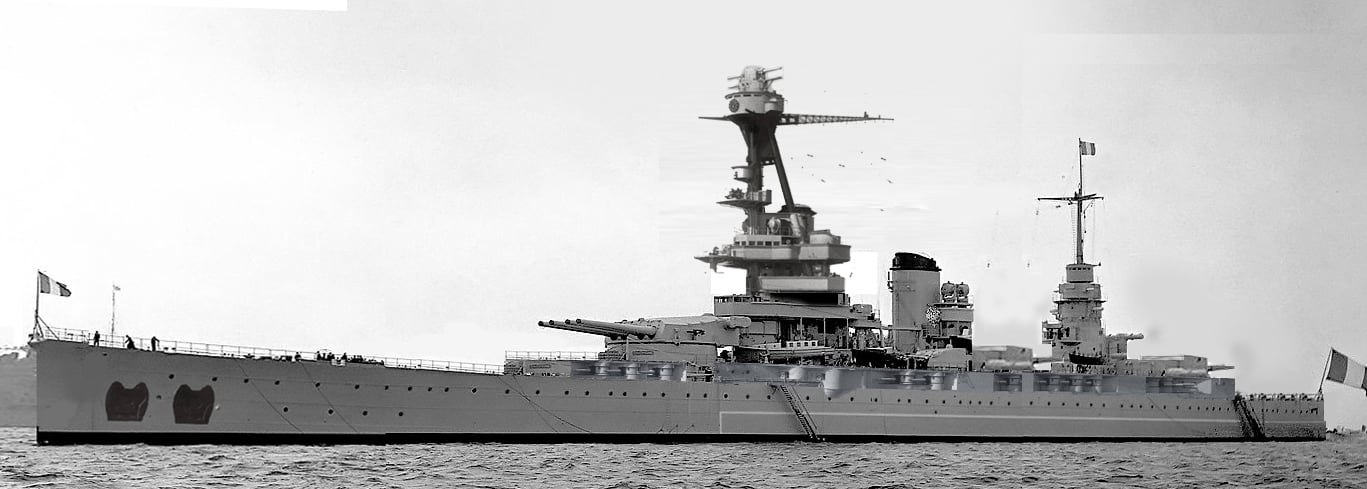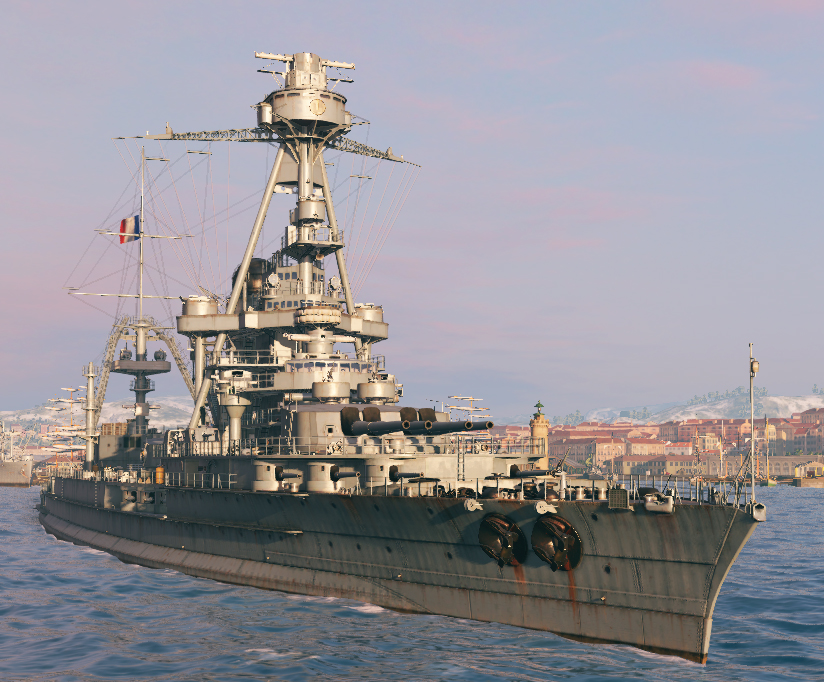French what-if battlecruisers
A bit provocative in its title, this article is dedicated to French prewar battlecruisers paper projects, proposed by officers Durant-Viel and P.Gille.
These were part of the ambitious 1912 naval plan that gets rid of the noxious Jeune Ecole school of thought, to concentrate on modern homogeneous classes of ships inspired by foreign navies like the Royal Navy and Hochseeflotte.
The 1912 plan was established by Admiral Boué de Lapeyrière, then minister of Marine, and included 28 battleships, 10 scout cruisers, 52 large destroyers, 94 submarines and a dozen colonial gunboats to be completed in 1920. Now this plan mentioned “battleships” and “scout cruisers” but nothing in between, although the battlecruiser concept was known since the Royal Navy introduced the Invincible class in 1909. That’s why the plan was revised in 1914 to comprise eight grands éclaireurs d’escadre which loosely translates as “large squadron scouts”. These were battlecruiser by all but name and were planned by two officers, Pierre Gille, and Durant-Viel which proposed three designs, respectively. The final versions were inspired by the Queen Elisabeth class and were more akin fast battleships than battlecruisers. Whatever the case, the war ensured these projects stayed on paper, although the budget rose from 333 million francs to 567 in 1913.
French planned battleships
France was much more advanced in dreadnoughts, in fact, two classes had been planned, and the first was already on construction when he war broke out: This was the Normandie class battleships, of which only the Béarn, laid down in January 1914 and only launched after modifications in 1920, was eventually completed as an aircraft carrier due to the Washington treaty limitations. The four others, Flandre, Gascoigne, Languedoc, and Normandie has been launched in October 1914 to may 1916 but were broken up after the war.
More impressive were the Lyon class battleships which added a quadruple turret (four total) to the design and reached a 30,000 tons weight. They made in numbers and quick-firing what lacked in caliber (340 mm versus 380 to 406 mm at that stage) with a full broadside of 16 guns per ship. None of the Duquesne, Lyon, Lille, and Tourville designed by M.Doyere had been laid down when the war broke out, although they had been planned to be started in late 1914 by Brest, La Seyne, St Nazaire and Lorient yards. We can only dream how these could have fared in ww1, or ww2 if properly modernized like the Regia Marina did with their Cavour and Caesar class dreadnoughts.
Gille’s battlecruisers
The requirements specified by the Ministry of Marine was of a 28,000 tonnes, 27 knots, eight-340 mm armed class of ship. This led to three designs, and one by Gille, which was submitted in 1913.
Gille’s design was called “cuirassé-croiseur” instead of the reverse “croiseur cuirassé”, the usual denomination for armored cruisers, now obsolete. This could only mean the design was intended more like fast battleships like the Queen Elisabeth class, but with a somewhat lighter armor, 270 mm for the main belt here (10 in). The preliminary designs of 1912 planned ships armed with eight 340 mm total, whereas Gille’s design paralleled the new Normandie class battleships with quadruple turrets. This made for a total of 12 guns, in three turrets, the same caliber ensuring lower ammunition and maintenance costs. These 13.4 in, 15 calibers model 1912 were relatively fast-firing (2 rounds per minute), and made for numbers what they lacked in shell weight. Quadruple turret management, however, if procuring advantages like a reduction and concentration of armor, was risky if it was hit. It also could be problematic in terms of dispersion.

Rendition (src: Rengokuy) of the Gilles type.
The hull was built as a model and extensively tested in a pool during the design process so engineers were very confident the hull lines of the ships were to be highly efficient. However, the main battery turrets being quite heavy, this imposes the whole range of modifications to enhance the hull’s solidity, with heavy-duty longitudinal beams and bracing, and strengthened inner and outer skins of the hull. Metacentric height was calculated as 1.03 m (same as the Lion class). The steam direct-drive turbines developed 80,000 shaft horsepower (60,000 kW), fed by 52 coal-fired Belleville boilers. In 1912 there was no prospect of using oil-fired ones yet. Each shaft was connected by a high, medium and low-pressure turbine. The direct drive turbine was used for the reverse. The 340mm/45 Modèle 1912 guns were the same already made by Schneider-Creusot for the Bretagne and future Normandie class.
The arrangement was identical to the latter, with a single forward turret installed on a secondary battery superstructure, while the two aft were arranged in a superfiring position. In any case, this would have given a formidable broadside of 12x 240 mm guns, four in chase and eight in retreat. This caliber for these pieces using separate charges and shell was proper to the French Navy. It was more or less equivalent to the British 343 mm developed at that stage and were find light enough to be distributed in quadruple turrets. (WW2 King Georges class which also had two quadruple turrets would use a not-so-far 360 mm caliber rather than the very heavy 381 mm). The many cancellations that followed found these spare guns converted as railway guns, and later whole turrets were used for coastal defense.
Gille’s design specifications |
|
| Dimensions | 205 x 27 x 9 m (672 x 88 x 30ft) |
| Displacement | 28,247 t. – 30,000 t FL |
| Crew | 41+1258 |
| Propulsion | 4 propellers, 4 shaft-geared turbines, 52 coil-fired boilers, 80,000 hp. |
| Speed | 28 knots. max. (52 km/h; 32 mph) |
| Range | 6,300 nmi (11,700 km; 7,200 mi) @15 knots |
| Armament | 12× 340mm/45 M1912, 24× 138.6mm M1910, 6 TTs 457 mm |
| Armor | Belt 270, turrets 270, blockhaus 250?, barbettes 250? mm, Decks 80? mm |
Durand-Viel’s battlecruisers
In 1913, some Naval College students submitted several cheaper fast capital ships with 27,500 tons in displacement to the Admiralty. Lt. Durant-Viel was the only one designing a battlecruiser. He drew two designs that were studied by the Admiralty in June 1914. Durant-Viel saw his ships forming a fast division, able like a cavalry to encircle and pummel slower capital ships.
Durant-Viel’s type A internal arrangement scheme
Durand-Viel’s A type battlecruiser
“A” design displaced 27,500 t (27,100 long tons; 30,300 short tons) and was 210 m long for 27m wide. Thy should have been propelled to 27 knots thanks to four sets of direct-drive turbines and 74,000 shaft horsepower, fed by a set of 22 mixed boilers. The normal range would have been 3500 nm, and there has been enough fuel for six hours of combat speeds. Armament relied, as above, on the trusted 340mm/45 Modèle 1912 naval gun, but also in a quad configuration. However compared to the “heavy” Gilles design, they only had two turrets, like the future Dunkirk class, but for and aft. Secondary armament relied on the local 138.6 mm Modèle 1910 guns mounted in casemates. The forward turret, like the Normandie, was mounted on the forward casemates superstructures. It is established this smaller caliber (compared to the mainstream 152 mm/6 in) had less punch but were faster-firing.
Such a large number to bear and this rate of fire was thought enough and better suited to deal with torpedo boats, while the 6-in was generally seen fit to engage larger ships altogether. As customary also the design incorporates four submerged TTs for close and personal duels. The entire protection was copied from the Normandie, but slightly thinner. The belt was 280 mm thick, as compared to HMS Lion’s 229 mm as an example.
So in general philosophy, these ships would have been a bit like German battlecruisers, a bit slower (HMS Lion 27.5 knots), slightly less heavily armed (340 rather than 343 mm guns, same for secondary), but better protected. A formidable counterpart for the future Normandie and Lyon anyway.

Possible reconstitution of the Type A if modernized in the 1930s.
Durand-Viel A design specifications |
|
| Dimensions | 210 x 27 x 9 m (689 x 88 x 28ft) |
| Displacement | 27,500 t. – 29,000 t FL |
| Crew | 1299 |
| Propulsion | 4 propellers, 4 shaft-geared turbines, 24 mixed boilers, 74,000 hp. |
| Speed | 27 knots. max. (50 km/h; 31 mph) |
| Range | 3,500 NM (6,500 km; 4,000 mi) @15 knots |
| Armament | 8× 340mm/45 M1912, 24× 138.6mm M1910, 4× 450mm (18 in) TTs |
| Armor | Belt 270, turrets 270?, blockhaus 250?, barbettes 240? mm, Decks 80? mm |
Durand-Viel’s B type battlecruiser

Photomanipulation showing the Type B as she could have been in 1940.
The “B” was designed a bit as a counterpart for the projected Lyon class battleships. The main difference was a much heavier broadside with brand new 370 mm guns (nearing the projected British 381 mm adopted by the Renown from 1916). As the same displacement was kept, compensation was obtained by a reduction in the armor protection (secondary guns) and increased power. This would have consisted either of four sets of direct drive turbines (63,000 hp) or steam-geared turbines (80,000 hp), with a corresponding top speed either of 26 or 27 knots. The new guns would have fired 880 kg (1,940 lb) shells able to penetrate 300 mm (12 in) of armor at 12,700 m. The secondary battery was increased by 4 guns, for 28 total. Armor scheme was identical to the “A” design but the hull was shorter by two meters. With such armor, secondary armament (even lighter) and heavy battery no doubt these ships would have been formidable opponents for any navy of the day.
Durand-Viel B design specifications |
|
| Dimensions | 208 x 27 x 9 m (682 x 88 x 28ft) |
| Displacement | 27,500 t. – 29,000 t FL |
| Crew | 1299 |
| Propulsion | 4 propellers, 4 shaft-geared turbines, 18 mixed boilers, 63,000 hp. |
| Speed | 27 knots. max. (50 km/h; 31 mph) |
| Range | 3,500 NM (6,500 km; 4,000 mi) @15 knots |
| Armament | 8× 370mm, 28× 138.6mm M1910, 4× 450mm (18 in) TTs |
| Armor | Belt 260?, turrets 250?, blockhaus 240?, barbettes 230? mm, Decks 70? mm |
The fact is the war erupted, and in August 1914 France seeing her territory invaded had no choice but commit all manpower available to counter the onslaught. As consequence shipyards were soon emptied and constructions halted. If that was not been the case, the Normandie would have emerged in late 1915, early 1916, the Lyon in 1917, mirroring the Battlecruisers. With such ships and former dreadnoughts of the Courbet and Bretagne, France in 1917 would have committed a modern battle fleet comparable to the Hochseeflotte rather than a collection of prototypes inherited from the “young school adventure”. We can only guess also if these ships would have been still in service at the start of ww2.
Links/sources
en.wikipedia.org/wiki/French_battlecruiser_proposals
navweaps.com/Weapons/WNFR_134-45_m1912.php – About the French 340 mm guns
Friedman, Norman (2011). Naval Weapons of World War I.
Le Masson, Henri (1985). “Some French Fast Battleships That Might Have Been”
Specs Conway’s all the world fighting ships 1906-1921.




 Latest Facebook Entry -
Latest Facebook Entry -  X(Tweeter) Naval Encyclopedia's deck archive
X(Tweeter) Naval Encyclopedia's deck archive Instagram (@navalencyc)
Instagram (@navalencyc)





 French Navy
French Navy Royal Navy
Royal Navy Russian Navy
Russian Navy Armada Espanola
Armada Espanola Austrian Navy
Austrian Navy K.u.K. Kriegsmarine
K.u.K. Kriegsmarine Dansk Marine
Dansk Marine Nautiko Hellenon
Nautiko Hellenon Koninklije Marine 1870
Koninklije Marine 1870 Marinha do Brasil
Marinha do Brasil Osmanlı Donanması
Osmanlı Donanması Marina Do Peru
Marina Do Peru Marinha do Portugal
Marinha do Portugal Regia Marina 1870
Regia Marina 1870 Nihhon Kaigun 1870
Nihhon Kaigun 1870 Preußische Marine 1870
Preußische Marine 1870 Russkiy Flot 1870
Russkiy Flot 1870 Svenska marinen
Svenska marinen Søværnet
Søværnet Union Navy
Union Navy Confederate Navy
Confederate Navy Armada de Argentina
Armada de Argentina Imperial Chinese Navy
Imperial Chinese Navy Marinha do Portugal
Marinha do Portugal Mexico
Mexico Kaiserliche Marine
Kaiserliche Marine 1898 US Navy
1898 US Navy Sovietskiy Flot
Sovietskiy Flot Royal Canadian Navy
Royal Canadian Navy Royal Australian Navy
Royal Australian Navy RNZN Fleet
RNZN Fleet Chinese Navy 1937
Chinese Navy 1937 Kriegsmarine
Kriegsmarine Chilean Navy
Chilean Navy Danish Navy
Danish Navy Finnish Navy
Finnish Navy Hellenic Navy
Hellenic Navy Polish Navy
Polish Navy Romanian Navy
Romanian Navy Turkish Navy
Turkish Navy Royal Yugoslav Navy
Royal Yugoslav Navy Royal Thai Navy
Royal Thai Navy Minor Navies
Minor Navies Albania
Albania Austria
Austria Belgium
Belgium Columbia
Columbia Costa Rica
Costa Rica Cuba
Cuba Czechoslovakia
Czechoslovakia Dominican Republic
Dominican Republic Haiti
Haiti Hungary
Hungary Honduras
Honduras Estonia
Estonia Iceland
Iceland Eire
Eire Equador
Equador Iran
Iran Iraq
Iraq Latvia
Latvia Liberia
Liberia Lithuania
Lithuania Mandchukuo
Mandchukuo Morocco
Morocco Nicaragua
Nicaragua Persia
Persia San Salvador
San Salvador Sarawak
Sarawak Uruguay
Uruguay Venezuela
Venezuela Zanzibar
Zanzibar Warsaw Pact Navies
Warsaw Pact Navies Bulgaria
Bulgaria Hungary
Hungary

 Bundesmarine
Bundesmarine Dutch Navy
Dutch Navy Hellenic Navy
Hellenic Navy Marina Militare
Marina Militare Yugoslav Navy
Yugoslav Navy Chinese Navy
Chinese Navy Indian Navy
Indian Navy Indonesian Navy
Indonesian Navy JMSDF
JMSDF North Korean Navy
North Korean Navy Pakistani Navy
Pakistani Navy Philippines Navy
Philippines Navy ROKN
ROKN Rep. of Singapore Navy
Rep. of Singapore Navy Taiwanese Navy
Taiwanese Navy IDF Navy
IDF Navy Saudi Navy
Saudi Navy Royal New Zealand Navy
Royal New Zealand Navy Egyptian Navy
Egyptian Navy South African Navy
South African Navy






























 Ukrainian Navy
Ukrainian Navy dbodesign
dbodesign